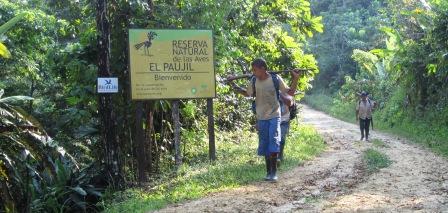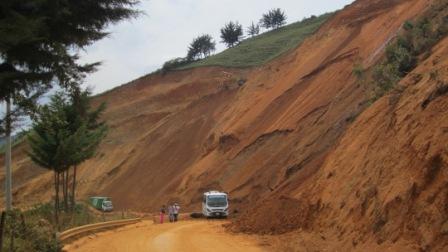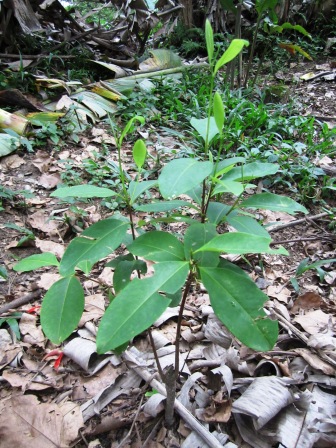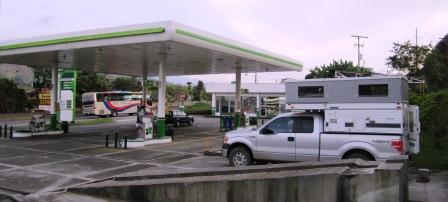calyptura.com
Jon and Anne's birding travels
Ecuador
Regrettably we fell far behind with the blog in Ecuador - we were just having too much fun birding solidly for nearly three months straight! Plus while regular internet cafes were easy to find, we found access to reliable fast wireless internet - which we ideally need for comprehensive blog updates - unexpectedly tricky in the remote areas where we spent much of our time. So all we can manage is a very brief summary of what we have did, and then a few photos, with (hopefully) more to come later.
We had a relatively modest 785 species in our time in Ecuador, but with exactly 40% of these have being new for us, this gives an idea of our focus. We spent our first couple of weeks in Ecuador in the mid- and high-elevation north-west, birding several great reserves and conservation projects, such as Reserva Las Gralarias, the Mindo Cloudforest Foundation properties, the Bellavista Cloudforest, and the Fundacion de Conservacion Jocotoco (FCJ, the main bird conservation organisation in Ecuador) reserve at Yanacocha, among others.
We then spent time at similar elevations on the east slope, including, thanks to a chance meeting with Rudy Gelis, one of the country’s most knowledgable birders, a great week based at Yanayacu Biological Station. Here we hooked up with volunteer Max Levy, a young Brit birder, whose enthusiasm was disarmingly reminiscent of Jon at a similar age! The three of us ended up birding several sites in the area together, to the enjoyment of all. This period produced many great birds, and some truly memorable rarities such as point-blank views of Barred Antthrush and Greater Scythebill.
In all these areas, as antpitta “purists” we managed to avoid seeing any antpittas at the increasingly frequent zoo-like feeding stations that have been established for them at some sites, preferring to see them in the wild, despite the greatly increased difficulty that that involves.
A little further downslope, another completely fortuitous meeting with one of the co-owners found us camped at the superb Wild Sumaco lodge for three nights. Jim and Bonnie were extremely kind to us, and as the lodge was empty they let us camp there for just the daily trail fee. We could only respond by birding the area as hard as possible in the available time, and among many other things we apparently set a record with 26 species of hummingbird within their reserve in a two-day period!
After a few days nibbling at the edge of true lowland Amazonia at another excellent NGO reserve project, Jatun Sacha, we headed back toward Quito, picking up Max en route, and birded our highest point so far, over 4200m (13,900 feet) in the Papallacta pass area for a couple of days. The rigours of birding in such cold, windy conditions were easily offset by camping outside a thermal pool complex just below the pass, where the three of us luxuriated in a hotter-than-a-bath pool for an hour before dusk!
to be continued...
Trampolín de Muerte
Our last act in Colombia was some exploratory birding in the extreme south of the country along the “road” that runs from Mocoa in the lowlands just east of the Andes up to Pasto at 2500m high up in the central Andes. This route has only ever been birded by a handful of people, and none of the Colombian ornithologists we met had ever travelled it. Known locally as the “Trampolín de Muerte”, it is unpaved rock and gravel, usually only the width of a single vehicle, extremely sinuous, and in the initial climb from Mocoa you gain over 1500m (5000 feet) in about 20km....but at least it is (probably) no longer the hideout of guerillas! (For the non-Spanish speakers, muerte means death, and you can probably work out the rest.)
The trip was probably the highlight of a superb two months in Colombia. Although just under 150km between Mocoa and Pasto, the local bush taxis - mainly Toyota pick-ups - do the journey in about five hours, although the vehicles, and sometimes their inhabitants, pay the price. We took six days.
One of the fascinations with birding in the Andes is that the species composition changes with elevation, and so on a road that passes through so many elevational bands, the bird diversity is superb.
to be continued....
Colombia revisited
Added 2nd March 2011
It is hard to believe we have been here in Colombia for nearly six weeks, it has been so packed with great birds, places and people that time has flown. After over a month of very intensive birding (and driving) we have stopped for a few days just outside Mocoa, near the Ecuadorian border, just into Amazonia. This is a major change from much of our time in Colombia which has been in the Andes, usually at 2000m or more.
We birded much of northern and central Colombia in an intensive four-week trip in early 2008 with our friends Martyn and Veronica, so our time now in 2011 has been even more focused on rare and localised species that we did not find then. With the continuing improvement in the security situation, even in more populous Central Colombia many additional areas have opened up to safe access in the last few years, so we have been able to track down all but a couple of the tough species that we had not found previously.
Bird highlights (so far) have included nine antpitta species (although only four of these were actually new, the very recently described Fenwick's, Moustached, Ochre-breasted, and a soon-to-be-split taxon of Rufous), a similar number of tapaculos including all three endemic species not seen in 2008, critically endangered birds such as Blue-billed Curassow and Fuertes's Parrot, Tolima Dove, the remaining endemic brush finch species we hadn't seen, plus several excellent new hummingbirds, taking our total number of hummers seen since we crossed into Mexico to 130 species.
The excellent Colombian bird conservation organisation ProAves now has several more reserves accessible than was the case even just three years ago, and of course these are specifically located to conserve the most endangered species. This has been the first time that the organisation has had to deal with independent travelers using their own vehicle, and ProAves has been extremely helpful to us, allowing us to access and then park/camp in several of their reserves at extremely reasonable cost. (Visitors typically arrive in organised tour groups, or at least with a ProAves guide/fixer.)
We have encountered very friendly and helpful people virtually everywhere we have travelled - Mexico in particular stands out in this regard - but Colombia takes the prize so far for such remarkably pleasant and genuinely friendly folk. This has helped make traveling here a real pleasure, and although we have many great countries ahead, we'll be somewhat disappointed to leave in a week or so.
Here in Mocoa, we are camped in the garden of a hostel owned and run by Felipe, an ex-pat Belgian, for a few days to calm down a little after several frenetic weeks. Felipe has taken a bit of a gamble to set up his accomodation here in Mocoa, which has only really opened up on the last few years, but the place is really nice and hopefully he'll be succesful. We are the first camper vehicle he has had (as has been the case almost everywhere we’ve ben in Colombia), and we are enjoying the luxuries of a shower - no hot water necessary here in Amazonia - plus wifi access and laundry.
Next up is to slowly climb back up into the Andes to Pasto, a route that has only ever been done by a handful of birders. If we get confirmation of the security situation, we'll probably head down the western side to a ProAves reserve in Nariño near Junin. Then into Ecuador by 14th March (the date our Colombian sixty day vehicle permit expires).
Some examples of conservation problems in Colombia. Above, a view of the north eastern Andes from the ProAves Hormiguero reserve. Even on the steepest ridges there is extensive clearance of forest. What forest remains (the dark patches) is extremely fragmented, and such fragments support many fewer species. In the inter-Andean region, based on our observations throughout the country, little intact forest remains below 2000m anywhere. Below, a view from our campsite at the entrance to the ProAves Paujil reserve. This reserve conserves a population of the Critically Endangered Blue-billed Curassow (which we were very fortunate to see on our second day there). The local men walking past, who were very amiable and chatty, are all carrying rifles to shoot whatever game they can find....including curassows, if they are very fortunate to find one. This was a major coca growing area until recent spraying by the Colombian military destroyed the coca crops, and the local economy with it. This makes the campesinos even more dependent on subsistence lifestyles such as hunting. Of course, such problems are not confined to Colombia, and we have seen similar issues throughout our travels in Latin America.

When we are not camped in beautiful forests and other wild country...we may well stay at a petrol station! On our long, slow drives between sites, without fail petrol stations throughout Latin America have always let us camp tucked away in a corner somewhere. They have 24 hour security, water, bathrooms (often with showers), very friendly staff, and they are free....what more could you ask for? Sometimes we even buy petrol at them too!
Our arrival often attracts a fair bit of attention, as such new vehicles are so unusual in Latin America, let alone one with a little house on the back! This was especially true at the ProAves reserve Las Tangaras on the west slope of the western cordillera in the remote Choco region of Colombia. The reserve facilities were still under construction, and we arrived on a Saturday, so many of the villagers were helping with the building, and they had their kids with them, so the crowd was especially large, as Anne explained the layout inside. The reserve is situated about 5km from one of the wettest locations in the World, but we were very fortunate to only have the odd shower every day, and did not lose any significant birding time to the weather.

Landslides are just part of the territory traveling in Latin America, but this one was huge, even by Colombian standards. The dry season arrived literally days before we got to Colombia, thankfully, but the 2010 wet season had been unusually tough, as it was in much of Central America.

You can't travel in Colombia and not photograph a coca plant. Apart from anything else it is a good idea to know what they look like, in case you stumble on a field of them. Every residence is legally allowed to own one, for personal uses only, such as coca tea. Thankfully we didn't stumble across any fields of them, although in several lowland areas we saw military helicopters that we were told were out trying to find them for subsequent destruction.
For reasons that were completely unclear, in Cartagena (on the Caribbean coast, where we waited for our vehicle to arrive by ship) there is a small park with a huge statue of Great-tailed Grackle in the middle. This species seemed a rather odd one to commemerate, being neither rare nor special to Colombia. But there were lots of them in the city. Hopefully they appreciated their statue.
Image copyright notice
All images on this website are subject to copyright (© Jon King, unless otherwise stated). If you wish to use them, whether commercially or non-commercially, please inform Jon by email.
Images appearing on calyptura.com can be used free of charge by individuals and non-profit organisations for strictly non-commercial use. They can be linked or copied to other websites, or downloaded to personal computers. The only exception to this policy concerns non-commercial use of images by any individual or organisation promoting trade in captive birds, or any other activity deemed detrimental to wild birds and their habitats. This use is not permitted.
All other commercial use of images is unauthorized. If you would like to use images for any commercial purpose (i.e. publication in books, magazines, commercial websites, advertisements etc.), or if you are seeking higher resolution scans, slide duplicates or prints, please contact Jon by email.
Jon and Anne's birding travels



